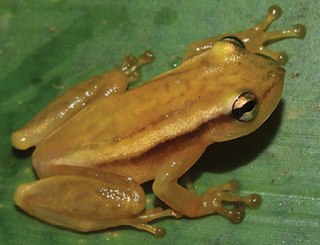
Phyllodytes is a genus of frogs in the family Hylidae. It is endemic to eastern Brazil.
Boana latistriata is a species of frog in the family Hylidae. It is endemic to Brazil and only known from its type locality, Itatiaia National Park, and from Marmelópolis, both in the state of Minas Gerais. The specific name latistriata refers to the wide stripes on the back of this frog.
Phasmahyla guttata, the spotted leaf frog, is a species of frog in the subfamily Phyllomedusinae. It is endemic to Brazil. It lives in forests and near the edges of forests but not outside forests. It has been observed between 50 and 1200 meters above sea level.
The Alagoas heart-tongued frog is a species of frog in the family Hylidae, the tree frogs and allies. It is endemic to Brazil, where it is known from coastal regions in Bahia, Alagoas, and Pernambuco. It has been observed as high as 550 meters above sea level.

Phytotriades is a genus of tree frogs in the family Hylidae. As currently delimited, the genus is monotypic and contains Phytotriades auratus, commonly known as the golden tree frog, bromeliad-dwelling treefrog, El Tucuche golden tree frog, or Trinidad heart-tongued frog.
The Alhandra heart-tongued frog is a species of frog in the family Hylidae endemic to Brazil. It has been observed as high as 100 meters above sea level.

Phyllodytes edelmoi is a species of frog in the family Hylidae endemic to Brazil. It has been observed as high as 650 meters above sea level.
Phyllodytes gyrinaethes is a species of frogs in the family Hylidae endemic to Brazil. Its natural habitat is subtropical or tropical moist lowland forests. It has been observed as high as 710 meters above sea level.

The Brazilian heart-tongued frog is a species of frog in the family Hylidae endemic to Brazil's Atlantic forests. It has been observed as high as 600 meters above sea level.

The yellow heart-tongued frog is a species of frog in the family Hylidae endemic to Brazil. It has been observed as high as 650 meters above sea level.

The Bahia heart-tongued frog is a species of frog in the family Hylidae endemic to Brazil's rainforests. It has been observed as high as 800 meters above sea level.
The Maracas heart-tongued frog is a species of frog in the family Hylidae endemic to Brazil. Its natural habitats are subtropical or tropical dry forests, dry savanna, and moist savanna. People have seen this frog between 900 and 1350 meters above sea level.

Phyllodytes wuchereri is a species of frog in the family Hylidae endemic to Brazil in the Atlantic forest in the state of Bahia. This frog has been observed 400 meters above sea level.
Sphaenorhynchus bromelicola, the Bahia lime treefrog, is a species of frog in the family Hylidae. It is endemic to eastern Brazil and only known from its type locality near Maracás, Bahia. It is similar to Sphaenorhynchus orophilus. It lives in terrestrial bromeliads on the forest edge and in open areas. The tadpoles develop in permanent pools. It is abundant at the type locality. Potential threats to this species include habitat loss caused by agriculture, wood plantations, logging, collection of bromeliads and human settlement, though data is insufficient to grant it conservation status.

Xenohyla eugenioi is a species of tree frog in the Hylidae family native to northeastern Brazil in ecotones between the Atlantic Forest and caatingas. It has been found in the Brazilian states of Bahia and Sergipe, approximately 1,000 km away from the other species in its genus, Xenohyla truncata. Like its relative, this frog spends the day hiding in bromeliads, emerging at night to hunt and forage. This frog has been observed between 128 and 960 meters above sea level.
Xenohyla truncata, the Izecksohn's Brazilian treefrog, is a species of frugivorous tree frog in the family Hylidae. It is endemic to the State of Rio de Janeiro, Brazil.

Phasmahyla spectabilis is a species of frog in the subfamily Phyllomedusinae. It is endemic to Brazil and known from the north-eastern Minas Gerais and adjacent southern Bahia. It occurs in fragments of Atlantic Forest at elevations of about 800 m (2,600 ft) above sea level.People have seen it as high as 850 meters above sea level.

Phyllodytes maculosus is a species of frogs in the family Hylidae endemic to Brazil's rainforests. It has been observed between 77 and 837 meters above sea level.
Phyllodytes megatympanum is a frog in the family Hylidae endemic to Brazil. It has been observed between 90 and 95 meters above sea level.

Phyllodytes praeceptor is a species of frog in the family Hylidae endemic to coastal areas in the state of Bahia in Brazil. It has also been seen in Serra da Jiboia, 694 m above sea level.










